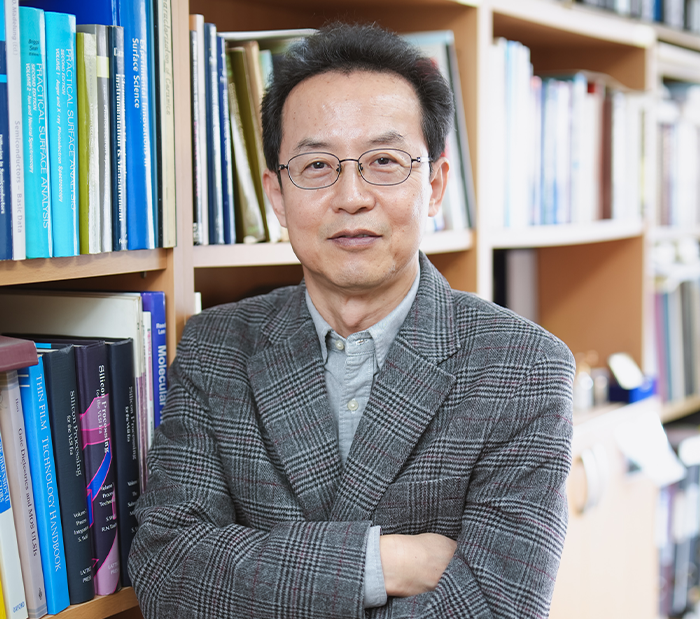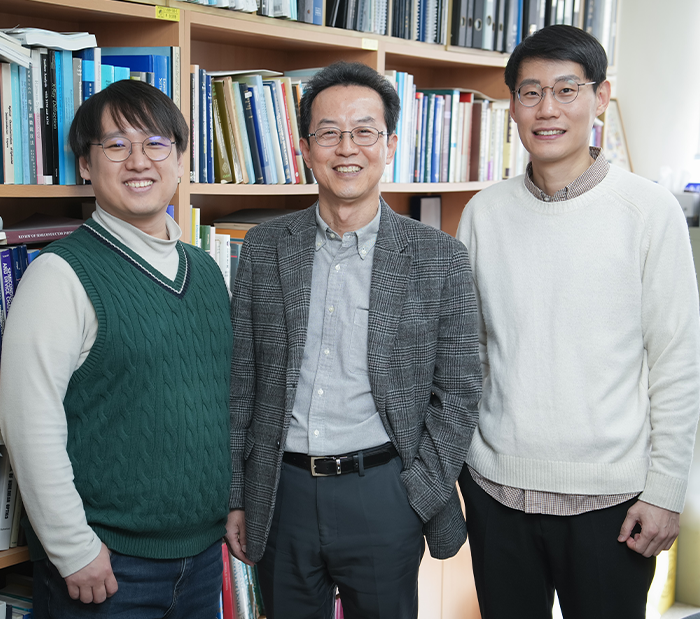Predicting and demonstrating of hidden metastable phase in transition metal oxide
Advanced Materials Science and Engineering LEE, JAICHAN Prof. · Bongwook Chung
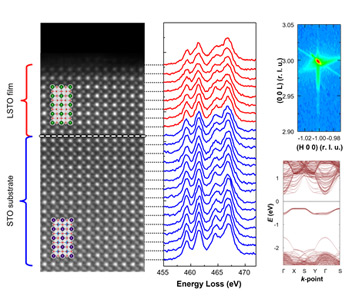
-
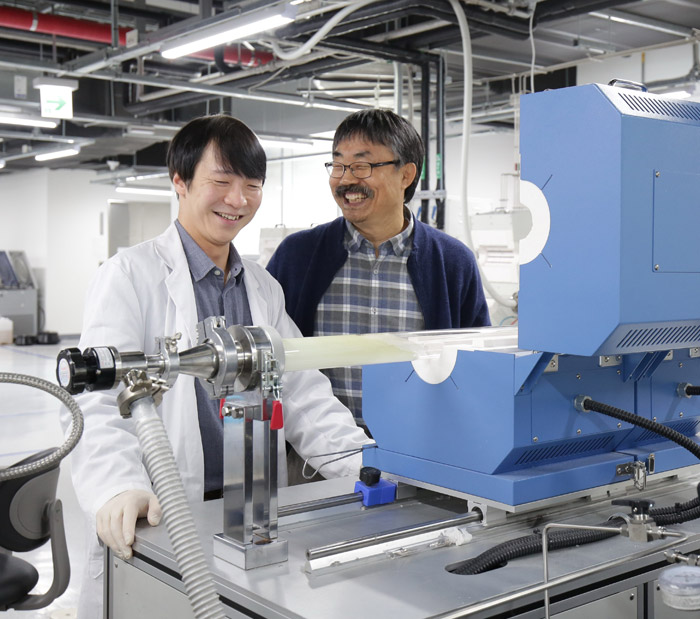
Physics LEE, YOUNGHEE Prof.
Solution to the heterologous synthesis of “Two-Dimensional Matter”
Prof. Younghee LEE (Dept. of Energy Science) has developed a technology to synthesize Hexagonal boron nitride, a Two-Dimensional matter composed of two elements (nitrogen and boron) into a single crystal through a joint research. *Hexagonal boron nitride; hBN: a flat layered material composed of boron and nitrogen with an atomic structure of a hexagon (like graphene) The result of the research has been published in the world-renowned international journal Science (issue date: November 16th). *Title of the thesis: Wafer-scale single-crystal hexagonal boron nitride film via self-collimated grain formation *Lead author: Researcher Joosong LEE(KIST, 1st author), Dr. Soomin KIM (KIST, Corresponding author), Head Younghee LEE (IBS, Corresponding author), Prof. Kigang KIM (Univ. of Dongguk, Corresponding author) Two-dimensional matters are excellent in the electrical feature, flexibility and transparency and is recognized as the core element of future electronic devices. It blocks the penetration of gas, which makes it suitable to be used for the protection of the elements. Boron nitride is receiving attention for its use as an insulation shield of transparent flexible electronic devices because it is the only two-dimensional matter that has the feature of insulation. However, the problem remains as they need to solve the issue of synthesizing it into a single crystal in order to keep the feature of boron nitride. The large-scaled boron nitride from the previous synthesis method was synthesized into a form of polycrystal, which showed deficiency in insulation and atomic linkage. Single Crystal: the state of crystals gathered in a specific order Polycrystal: many crystals are gathered in an irregular form. The linkage between crystals are imperfect The research team was able to synthesize a thin-film of single crystal boron nitride by using the phenomenon of self-collimation on the surface of liquid gold. This method enables the synthesis of single crystal regardless of the size of thin-film. *Self-Collimation: when the crystal grain of boron nitride is formed on the surface of the liquid gold, nitrogen and boron atoms cause an electrical gravitational pull to push and pull one another to keep an optimal distance. Also the team was able to synthesize other two-dimensional matters such as graphene, WS2, MoS2 into a single crystal by using the thin-film. They were also successful in synthesizing graphene and boron nitride into a form of layered structure. *Graphene: one of allotropes of carbon. The carbon atoms are formed in a shape of hexagon with a thin layer and shows high physical and chemical stability. The research is evaluated to have opened a new paradigm by developing an original technology to synthesize two-dimensional matter into a large-scaled single crystal. It is expected to bring innovation in the development of future transparent flexible electronic devices, gas barrier, sensors and filters. This research was conducted with the support of the Ministry of Science and ICT, Institute for Basic Science and the KIST (Korea Institute of Science and Technology). [Figure 1] A mimetic diagram of large-scaled single crystal synthesis due to self-collimation and two-dimensional boron nitride crystal grain [Figure 2] The synthesis of two-dimensional matters with the use of large-scaled single crystal boron nitride. Observed that it is arrange in a single direction. [Figure 3] Effective in improving the penetration of moisture in air and oxidation of metal despite the 0.3nm of thin-film.
- No. 102
- 2019-02-18
- 3410
-

Medicine KIM, KYEONG KYU Prof. ·Dr. REKHA ARYA
Finding a hope to overcome antibiotics resistance from the herbal plant
According to the Sweden Global Challenges Foundation, antibiotic resistance is one of top 10 global catastrophic risks, and a solution needs to be found emergently. UK Parliamentary Papers in 2016 warned that over 10 million people will die in 2050 from superbacteria, if a solution to the antibiotic resistance problem cannot be found. It is certain that the antibiotics resistance is a problem of urgency and grave seriousness. Antibiotic resistance is a natural phenomenon that occurs inevitably as the bacteria adapts to the antibiotics through the process of mutation. Hence, developing new antibiotics with a new mechanism is necessary. Prof. Kim’s team identified that xanthoangelol B, which was extracted from ashitaba, inhibited the synthesis of virulence factors in Staphylococcus aureus, one of the most serious antibioticresistant bacteria, and induced clearance through a host immune response without pathogenesis. The group additionally established chemical synthesis methods for xanthoangelol, and prepared its derivatives. Among such derivatives, PM-56 showed anti-virulence activity more effective than that of the original xanthoangelol. Ashitaba is also called the “Hermit grass” and the name came from the traditional belief that those who eat ashitaba can become Taoist hermits. Also, its binomial name, Angelica utilis, is translated as “angel’s gift”. As the names suggest, ashitaba was believed to have special drug effects, and has been widely used as a healthy ingredient. This research has proven its effect by discovering its antivirul role. Professor Kyeoing Kyu Kim said, “In this study, we successfully validated a potency of the virulence-inhibitory antibiotics as a new concept of antibiotic mechanism. We expect further development of new therapeutic approaches for bacterial infection, which are free from drug resistance.” This study was conducted in “Institute for antimicrobial resistance and therapeutics” (https://shb.skku.edu/iamrt/), and published in Medicinal Chemistry (Nov, 2018). In addition, it was introduced in YTN science and Donga Newspaper. YTN Science: https://youtu.be/Ax_Rd8-85IM Donga Science: http://news.donga.com/3/all/20181202/93122384/1 Figure 1. Mechanism of PM-56, antivirulence inhibitor, to S. aureus. PM-56 blocks relay of phosphate group from a histidine kinase SeaS to a response regulator SaeR in SaeRS system. By blocking transfer of phosphate group, synthesis of virulence factors in downstream of SaeRS system is also blocked. Figure 2. Model experiment to validate antibiotic effect The viability of antibiotics resistant bacteria-infected Galleria mellonella larvae is 20% after 72 h. However, the viability of PM-56-treated larvae is increased dose-dependently, and finally 4.262 mg/kg body weigh-treated larvae shows 100% viability. It means S. aureus infection can be cured by the PM-56 treatment.
- No. 101
- 2019-02-08
- 4044
-
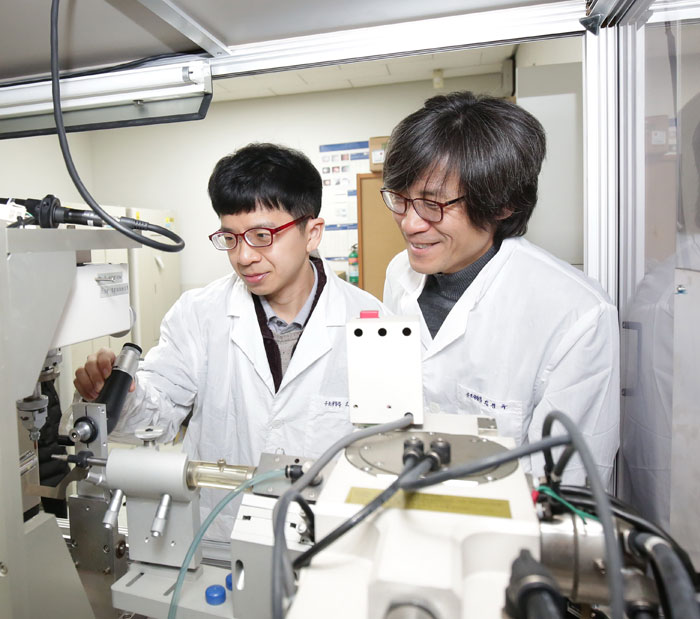
Medicine KIM, KYEONG KYU Prof. ·Dr. OH, CHANG SUK
Development of biocatalysts for anti-inflammatory drug synthesis
So far, the method of chemical synthesis had been used to produce fine chemicals such as medicine. However, the synthesis carries problems such as low economic efficiency and use of hazardous substances. The use of environment-friendly biocatalysts is one of the solutions to overcome these problems. The key advantages of the biocatalysts are the specificity of enzymes to substrates, reactions and stereoisomers, which can reduce the complexity involved in the process of chemical synthesis. Another great advantage is that it reacts in conditions at mild temperature, on atmospheric pressure, or in aqueous solution. For these reasons, the biocatalyst is under the spotlight as the core part of green chemistry, with less by-products and hazardous waste produced during the synthesis process. Protein engineering tools are applied in developing biocatalysts, by improving enzyme activities. There are two main streams in protein engineering: 1) directed evolution (the topic of Nobel Prize on Chemistry, 2018) and 2) structure-based rational design. Rational design is only applicable when structure and mechanism of the protein are available, but it is more efficient than the directed evolutionary approach. Ketoprofen, a non-steroidal anti-inflammatory drug, is an analgesic or a fever reducer, releasing inflammation and pain mediated by rheumatoid arthritis or osteoarthritis. It is used in external painkillers in forms of gel or patches. Ketoprofen has two stereoisomers, S- and R-form, with the S-form showing higher drug effect. The US Food and Drug Administrator guides that stereo isomeric drug should be an enantiomer, not a racemate. The ketoprofen from racemate is required to be highly purified. For high purity of ketoprofen in synthesis, Professor Kyeong Kyu Kim’s group identified 3D structure of esterase Est-Y29 complex, which is extracted from metagenomic library originated from soil in Korea, with (S)-ketoprofen in high resolution using X-ray crystallography. It showed that aromatic residues in substrate-binding pocket of the enzyme positively affects enantioselectivity of Est-Y29 to S-form by the interaction with ketoprofen ethyl ester (a precursor of ketoprofen). Based on 3D structural information of the complex, Kim’s group designed a mutant that has increased aromaticity in the substrate binding pocket and consequently succeeded in developing a new enzyme, whose enantioselectivity toward (S)-ketoprofen was about 5 times higher compared to wild-type. This research is noteworthy in its successful increase of protein function using rational design and the research has been published in ACS Catalysis Online on 2018 Dec 24. Professor Kyeong Kyu Kim explained the significance of the research as follows: “In the research, we developed a new biocatalyst which may displace chemical catalysts, using a 3D structure-based, protein engineering approach. It also proposes a potency of production of effective medicines such as ketoprofen, through environment-friendly methods.” Figure 1. The principal of enantioselectivity of Est-Y29 (S)-ketoprofen ethyl ester (SKE, magenta) forms π-alkyl interaction (pink dashed line) with aromatic residues (Y123, F125, Y170) in substrate-binding pocket of Est-Y29. However, most of the interaction was not shown to (R)-ketoprofen ethyl ester (RKE, blue), so S-form can bind to Est-Y29 more specifically. Figure 2. Increased production of (S)-ketoprofen in Est-Y29 F125W Replacement of phenylalanine at 125 in Wild-type Est-Y29 (top left) to tryptophan (Est-Y29 F125W, top right) increases aromaticity (orange) in substrate-binding pocket (cloud-like shape). The mutation increases affinity to S-form, and finally enhances (S)-ketoprofen production (bottom).
- No. 100
- 2019-02-01
- 3274
-
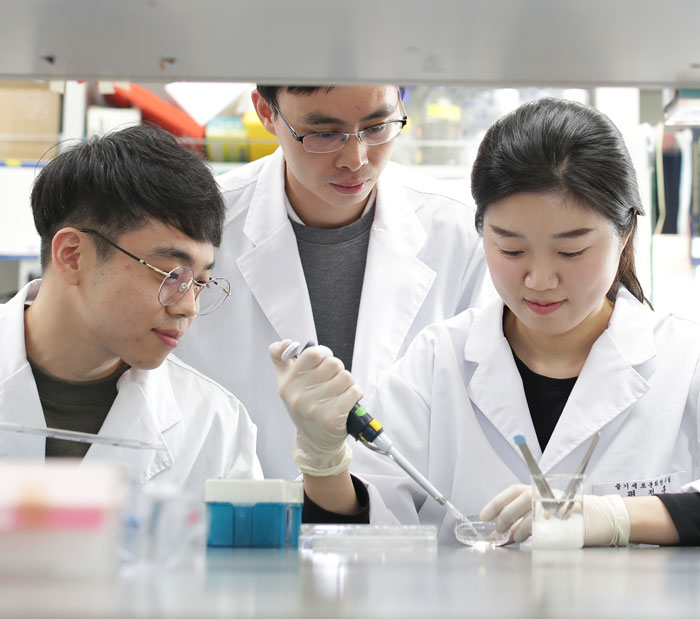
Medicine KANG, JONG SUN Prof.
Research on the role of Protein arginine methyltransferase 1 in preventing heart failure
Cardiac disease is one of the most common adult diseases and a leading cause of death worldwide. The increasing rate of cardiac disorder is due to westernized lifestyle and aging population. It is an urgent matter to develop a method of treatment by researching the pathogenesis of cardiac disorders. The cause of most cardiac disorders roots from the regenerating process of the cardiomyocyte. When the cardiomyocyte cannot self-regenerate, it chooses to extend or increase in size, resulting ‘Cardiac hypertrophy’. Cardiac hypertrophy is kind of an adaptive response to physiological and pathological stimuli. However, pathological cardiac hypertrophy leads to heart failure. This study exhibited that mice with deficiency of cardiac PRMT1 showed a rapid progression to dilated cardiomyopathy and heart failure within 2 months of birth. Heart failure was accompanied with cardiomyocyte hypertrophy and fibrosis. From this, the research team discovered that PRMT1 is essential for the maintenance and survival of the cardiac function. CaMKII δ(Calcium/calmodulin-dependent protein kinase II δ), which was identified as the main target of this study has been linked with maintenance of Ca2+ homeostasis by phosphorylating various proteins important for excitation–contraction coupling and cell survival including ion channels. Thus, they proved that dysregulation of CaMKII δ is closely linked with myocardial hypertrophy and heart failure. However, the mechanism that regulates CaMKII activity is still in need for further research. The most important finding of this study was the fact that the protein arginine methyltransferase 1 (PRMT1) is essential for preventing cardiac CaMKII hyperactivation. The level of active CaMKII is significantly elevated in PRMT1-deficient hearts or cardiomyocytes. PRMT1 interacts with methylates CaMKII, leading to the inhibition. Accordingly, pharmacological inhibition of CaMKII restores contractile function in PRMT1-deficient mice. Thus, our study suggests that PRMT1 is a critical regulator of CaMKII to maintain cardiac function and potential therapeutic target of cardiac disease. Figure 1. Discovered that PRMT1 is the main factor that controls the level of stress that causes hypertrophy Figure 2. Identified that PRMT1 controls the activation of CaMKII δ
- No. 99
- 2019-01-23
- 3088
-
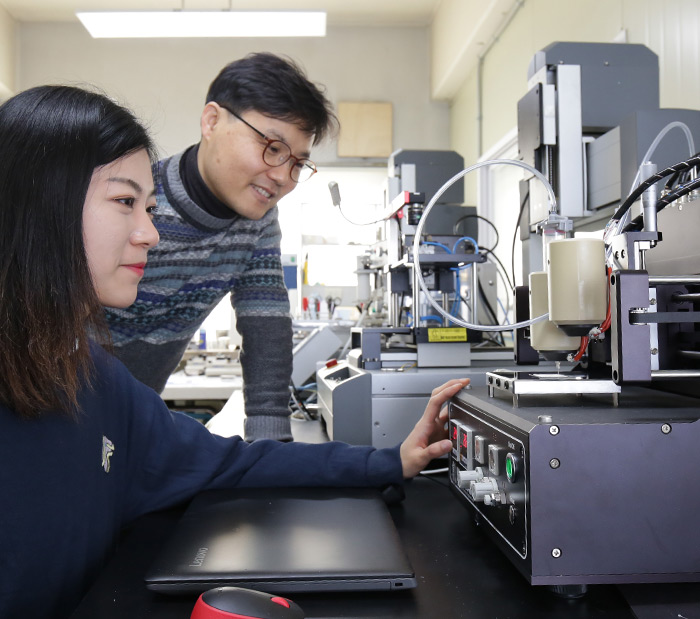
Bio-Mechatronic Engineering KIM, GEUNHYUNG Prof.
Development of muscle-mimetic cell-laden Nanofiber using 3D Cell-Electrospinning
Prof. Geun Hyung KIM and his research team reported that they have successfully aligned the nanofibrous structure by producing live myoblast cells and bioink suitable for electrospinning. Nano-muscular fibers implanted with live myoblast cells acted as if it were a real muscle tissue and accelerated the regeneration of muscle tissue by guiding the muscle cell to grow in a uniaxial direction. Tissue Regeneration Engineering is a field of study developed to improve the regeneration process of damaged tissues/organs by inserting a biological substitute, which is called scaffold. 3D cell-printing and electrospinning has been widely used for this process. However, the cells cultured by 3D cell-printing and electrospinning grew randomly, which was a serious problem for muscles that required its cells to be aligned for proper regeneration. To control cell morphology, they have developed electrospinning to a cell-electrospinning process. The research team used a biocompatible hydrogel to generate cell-laden nanofibers. Also, the hydrogel was added with a material with high processability to produce a bioink, which was applied with high-voltage direct current (Figure 1). After this, myoblast-laden nanofiber can be generated with an aligned pattern. -the myoblast-laden nanofibers showed over 90% of initial cell viability, which was a sign that it overcame the problem of low cell viability from the previous conventional cell-electrospinning process. Moreover, the cell alignment and differentiation improved threefold incomparison to the 3D cell-printing process (Figure 2). -the myoblast-laden nanofibers induced cells to grow in a uniaxial direction, which assists the regeneration of skeletal and cardiac muscle. Prof. KIM said, “This was the first case to successfully produce cell-laden nanofibers in uniaxial arrangement. It suggested a possibility to become a new method of regenerating aligned tissue structure.” This research was supported by a grant from the National Research Foundation of Korea funded by the Ministry of Education, Science, and Technology. It was selected as the cover page for a world-renowned journal, ‘Small’(Figure 3). * Read article at YTN Science Figure 1. Mimetic diagram of Electrospinning and electric radiation depending on the solution Figure 2. Comparison of newly developed electrospinnng and the previous 3D cell-printing process Figure 3. The cover page of 'Small'
- No. 98
- 2019-01-14
- 3580
-
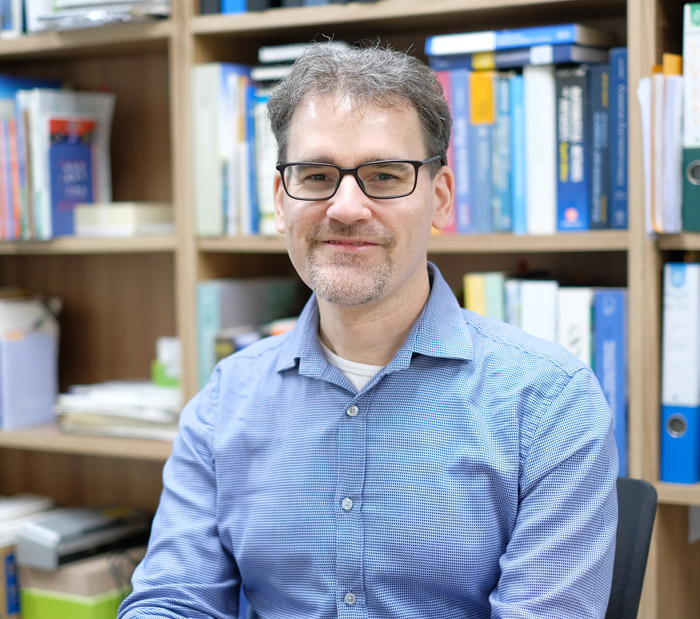
Physics ROTT, CARSTEN Prof. ·Student Woosik KANG
IBS contributes to the research on Dark Matter
COSINE-100 Collaborative Research Team* led by Physics Professor Carsten ROTT has opened a new path to uncovering the controversy surrounding the Dark Matter. *COSINE-100 International Collaborative Research Team: A team consisted of international researchers operating cosine experiments to investigate the Dark Matter (More than 50 researchers from 15 different international institutions participated in this research) The co-authors of this research are Professor Carsten ROTT and Woosik KANG (student) from the Institute for Basic Science. The team was able to suggest a possibility of verifying the signal of Dark Matter, which was claimed to have been observed through the DAMA experiment. The result of the research was posted on the scientific journal Nature’s online version on December 6th at 3AM (Korea Time). The thesis disproved many theories that were written based on the outcome of the DAMA experiment. The data extracted from the COSINE-100 experiment hints that the DAMA experiment is insufficient to prove that the signals are relevant to the Dark Matter. Currently two graduate students from SKKU are participating in the COSINE-100 experiment and they are researching on the simulation of detectors. The SKKU team is contributing to the research by monitoring the status of data that are produced by the detectors. The team joined this project from the stage of making detectors at a laboratory located in Yangyang county. Professor Carsten ROTT said, “This research set a new milestone in the study of Dark Matter” “The COSINE-100 experiment provided a direct and independent verification of the previous experiments” “We were not able to observe any signal in this experiment but the COSINE-100 is receiving attention in the scientific world as it will take a pivotal role in the future study of Dark Matter”. Professor said, “We will continue to collect data from the COSINE-100 experiment. We hope to fully understand the unusual phenomenon that were observed in the DAMA experiment” “The research did not prove the existence of Dark Matter, but we might have discovered a new phenomenon that we are not yet aware of”. Fig. 1 Exclusion limits on the WIMP-nucleoninteraction. The observed (filled circles with black solid line) 90% exclusionlimits on the WIMP-nucleon interaction are shown with bands for the expectedlimit assuming the background-only hypothesis. The limits exclude a WIMPinterpretation of DAMA/LIBRA-phase 1 of 3 σ allowed region (dot-contours). Thelimits from NAIAD, the only other sodium iodide based experiment to set acompetitive limit, are shown in magenta. Fig. 2. The COSINE-100 detector. The detector is contained within a nested arrangement of shielding components shown in schematic a). The main purpose of the shield is to provide full coverage against external radiation from various background sources. The shielding components include plastic scintillator panels (blue), a lead brick enclosure (grey) and a copper box (reddish brown). The eight encapsulated sodium iodide crystal assemblies (schematic c)) are located inside the copper box and are immersed in scintillating liquid, as shown in schematic b). For more information about COSINE-100, visit https://cosine.yale.edu/home or https://cosine.ibs.re.kr
- No. 97
- 2018-12-28
- 3587
-
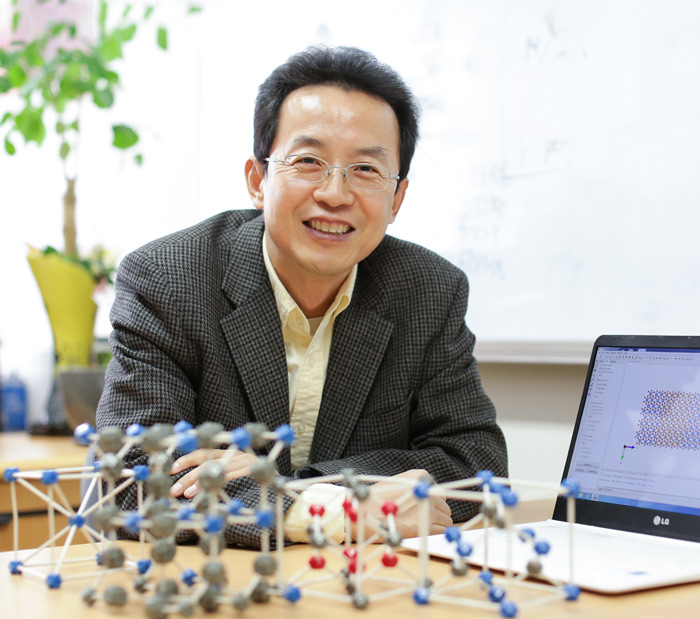
Advanced Materials Science and Engineering LEE, JAICHAN Prof.
Decoupling structure and electronics leads to purely electronic transition
□ Prof. Jaichan LEE at Sungkyunkwan University, Korea, Prof. Chang-Beom EOM at University of Wisconsin, Madison, USA, and coworkers reported a metal-insulator transition in VO2 occuring without structural change but only electronic change by decoupling structure and electronics. □ Metal-insulator transition in strongly correlated materials has been a central issue in fundamental science and technology. The metal-insulator transition is typically accompanied by structural phase transition, which makes it difficult to unveil the primary mechanism of the transition. Extensive debate has continued on the primary mechanism either electron-lattice (Peierls transition) interaction or electron-electron interaction (Mott transition). □ VO2 is an archetypal correlated material and has a metal-insulator transition specifically near room temperature, which provides great advantage in the device application. However, the device application has been limited because of the coupling of electronic and structural transitions. □ The research team decoupled the structural and electronic transitions in VO2 and demonstrated only electronic metal-insulator transition heterostructure engineering. □ Prof. Jaichan Lee said that this discovery and approach could be extended to correlated materials to unveil many unconventional phenomena and get a wide variety of material functionality. □ The article is published in Science 362, 1037 (2018).
- No. 96
- 2018-12-14
- 3332
-
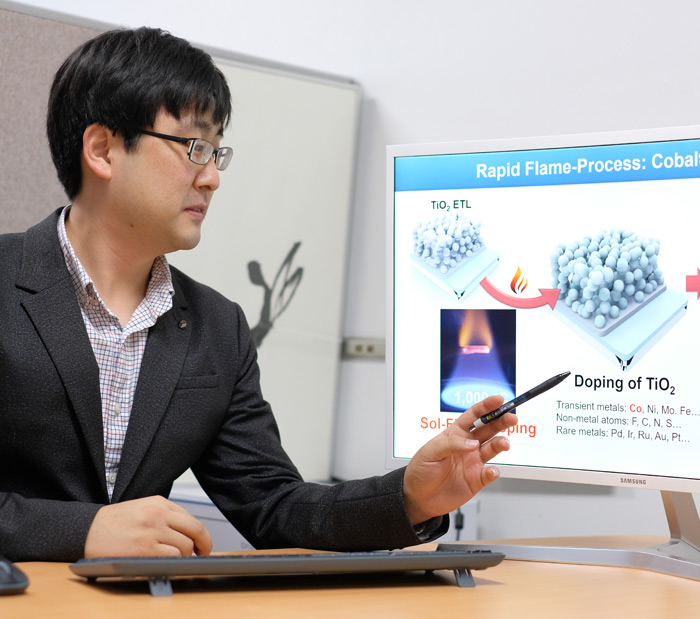
Chemical Engineering KIM, JUNG KYU Prof.
Development of Doping Technology by Baking Metal Oxide Thin Film for a Short Time
Prof. Jung Kyu KIM (School of Chemical Engineering) reported his research achievement on developing of a novel rapid sol-flame process to modify the energy state and electronic structure of nanoparticulated metal oxide films and their application for the charge transport/selective layer of perovskite solar cell with high efficiency. To further increase the open-circuit voltage (V oc) of perovskite solar cells (PSCs), many efforts have been devoted to doping the TiO2 electron transport/selective layers by using metal dopants with higher electronegativity than Ti. However, those dopants can introduce undesired charge traps that hinder charge transport through TiO2, so the improvement in the V oc is often accompanied by an undesired photocurrent density-voltage (J-V) hysteresis problem. Herein, it is demonstrated that the use of a rapid flame doping process (40 s) to introduce cobalt dopant into TiO2 not only solves the J-V hysteresis problem but also increases the V oc and power conversion efficiency of both mesoscopic and planar PSCs. The reasons for the simultaneous improvements are two folds. First, the flame-doped Co-TiO2 film forms Co-Ov (cobalt dopant-oxygen vacancy) pairs and hence reduces the number density of Ti3+ trap states. Second, Co doping upshifts the band structure of TiO2, facilitating efficient charge extraction. As a result, the flame doping of Co increases the efficiency from 18.5% to 20.0% while reducing the hysteresis from 7.0% to 0.1%. This research is expected to develop a wide variety of applications that use metal oxide such as information electronic devices, memories, and displays as well as energy conversion materials such as solar cells. The results of the research were published in the world's leading journal 'Advanced Energy Materials' on October 15th, 2018. *Research Title: Resolving Hysteresis in Perovskite Solar Cells with Rapid Flame-Processed Cobalt-Doped TiO2
- No. 95
- 2018-12-06
- 2899
-
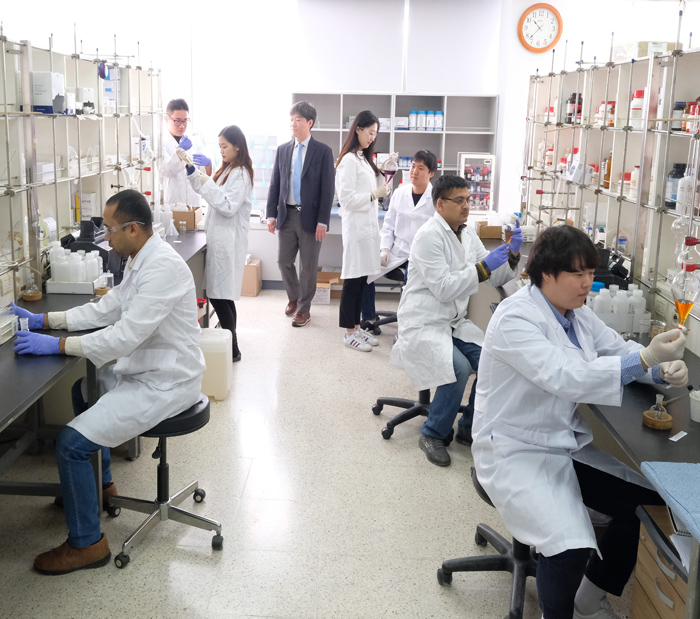
Pharmacy KIM, IN SU Prof.
Cheaper and Easier Synthesis of Drugs that are Widely Used in Anticancer & Antibiotics Medicines
A research result on cheaper and easier synthesis of main ingredients for drugs that are widely used in the manufacturing of anticancer medicines and antibiotics has been released. On Sep 6, Sungkyunkwan University announced that the research team of prof. In Su KIM from the School of Pharmacy has discovered a cheaper and easier method for producing pyridine and quinoline compounds, which are considered to be the all-round multifunctional medicines, by using a new reaction process. So far, Wittig reaction that was developed in 1952 by Prof. WITTIG was widely used in synthesizing of organic chemistry or drug manufacturing field, but it was only limited for generation of the carbon-carbon double bond through reaction with carbonyl, and it had relatively lower chemical reactivity and required a complex process that goes through a number of steps. Although there is a different method using expensive transitional metals such as palladium or rhodium, it is inefficient because an additional process is required for removing metals. The newly developed ‘Selective Alkylation of Pyridine and Quinoline’ by the research team uses direct alkylation reaction of the carbon-hydrogen bond present in pyridine and quinoline, instead of the traditional double bond formation reaction. The alkylation reaction breaking the carbon-hydrogen bond within a molecule allows easier and simpler synthesis of compounds that are used in various drugs, and this research result is a discovery of new reactivity by improving the existing problems of Wittig reagent. According to the research team, this new technique uses a principle of natural reaction between two substances, which are oxygen and phosphorous. It is done by applying Wittig reagent to the oxygen-injected pyridine or quinoline and controlling the reaction conditions including temperature and concentration to draw out the optimized reaction so that the oxygen from the pyridine or quinoline reacts well with phosphorus present in the Wittig reagent. As a research result that can suggest a new guideline to drug synthesis process, this discovery is published on the September issue of Angewandte Chemie (IF = 12.102), which is a world-class academic journal in the chemistry field. This research was conducted through the supports of Basic Research Laboratory (BRL) offered by the Ministry of Science and ICT and the National Research Foundation of Korea.
- No. 94
- 2018-11-23
- 2787
-
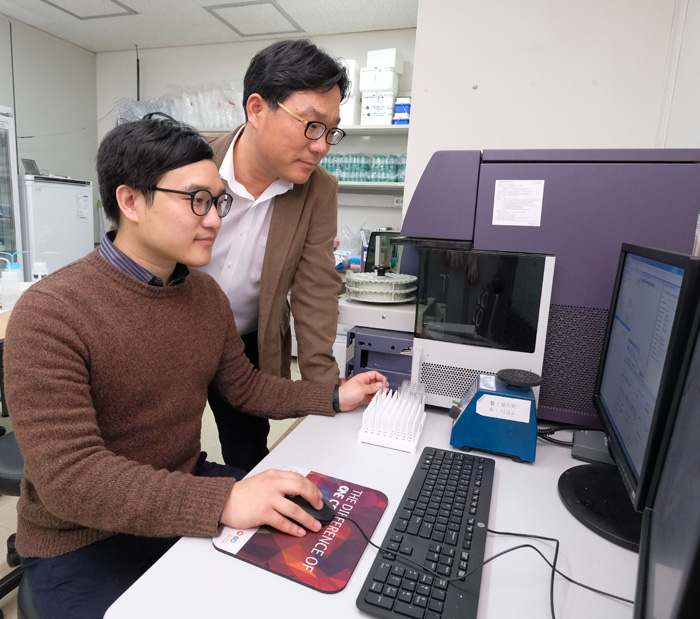
SKKU Advanced Institute of Nano Technology LIM, YONGTAIK Prof. ·Researcher Ren Long
Development of a Degradation-Regulatable Architechtured Implantable Macroporous Scaffold: Dr-AIMS
Professor Yong Taik LIM`s group from SKKU Advanced Institute of Nanotechnology(SAINT) of Sungkyunkwan University has developed a degradation-regulatable architechtured implantable macroporous scaffold (Dr-AIMS) for spatiotemporal controlling immunosuppressive factors in tumor microenvironment, resulting in an enhanced efficiency for combination cancer immunotherapy. The Dr-AIMS was fabricated based on hyaluronic acid, the intrinsically existing biopolymer in human, with the ability to regulate the degradation kinetics for varied applications. With scaffold implantation after surgery, the immunosuppressive cells (MDSC: Myeloid-derived suppressor cells; TAM: Tumor-associated macrophages) related with tumor recurrence and metastasis can be controlled and the ability of DCs and T cells can be revigorated with reduced side effects of chemodrugs and immune checkpoint antibodies. By this approach, the drawbacks of i.v. injection, including low targeting efficacy and varied side effects, could be addressed. Further, it can be developed as an on-demand drug delivery system based on the analysis of tumor tissues. Published article: L. Ren, and Y. T. Lim, ‘Degradation-regulatable Architectured Implantable Macroporous Scaffold for the Spatiotemporal Modulation of Immunosuppressive Microenvironment and Enhanced Combination Cancer Immunotherapy’, Advanced Functional Materials, 201804490 (2018) .
- No. 93
- 2018-11-14
- 2963
-
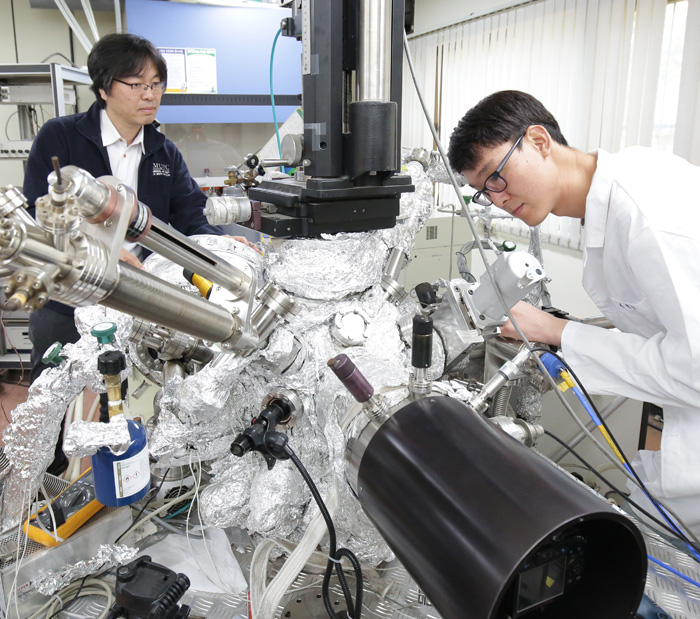
Physics AHN, JOUNGREAL Prof. ·Dr. AHN, Sung Jun
Study on Dirac Electrons in a Dodecagonal Graphene Quasicrystal
Quasicrystal is an unusual structure of solid that was first experimentally observed in the 1980s by Nobel Laureate Dan Shechtman. In a typical solid, the constituent elements are arranged with a certain periodicity called a lattice structure, and in this case, it has both translational and rotational symmetry. However, quasicrystals have a distinct structure with only rotational symmetry, and have fractal structure with self-similarity. In addition, there have been many theoretical and experimental studies on the interaction between two graphene layers, but unusual physical phenomena such as Mott insulator and superconducting phenomenon have been reported in the academic community until recently. We have recently published a study on two-dimensional quasicrystal using two graphene layers in accordance with these research trends. In this study, instead of stacking of separated two graphene layers, two-dimensional graphene quasicrystals could be synthesized by epitaxially growing two graphene layers having a rotation angle of 30 degrees. Then we first discovered a special quasicrystal with Dirac Fermions. The synthesized graphene quasicrystals were confirmed to have 12-fold symmetry and fractal structure which are not seen in general crystal structure as shown in the attached figure. It is expected that the physics in 4-dimensional space represented by 4D quantum Hall effect can be observed through this two-dimensional graphene quasicrystal. This research was published in Science on August 24, 2018 and was selected as a cover paper. Science 24 Aug 2018: Vol. 361, Issue 6404, pp. 782-786 DOI: 10.1126/science.aar8412
- No. 92
- 2018-10-30
- 3302
-

Pharmacy CHUNG, KA YOUNG Prof. ·Hee Ryung KIM, Ph.D. student
Elucidation of Wnt Signaling Mechanism
□ Professor Ka Young Chung's group (Hee Ryung Kim: Ph.D. student, co-first author, Global Ph.D. Fellowship) from School of pharmacy of Sungkyunkwan University (President Kyu Sang Chung) elucidated the mechanism of Wnt signaling in collaboration with the groups of Professor Hee-Jung Choi from Department of Life Sciences, Seoul National University and Professor Chaok Seok from Department of Chemistry, Seoul National University. □ Wnt signaling is an important signaling in which a type of hormone called Wnt controls embryo development, cancer and tissue regeneration in humans. Precise understanding of Wnt signaling will contribute to anti-cancer drug development significantly. □ Wnt signaling acts via Frizzled receptor, a type of GPCR family. GPCR families control various physiological functions such as vision, olfactory, cardiovascular and neuronal regulation, immune system and metabolism. Currently, 40% of commercialized drugs target GPCRs. Due to its importance, the scientists studying GPCR mechanism have been awarded with 1971 Nobel Prize in Physiology, 1994 Nobel Prize in Physiology and 2012 Nobel Prize in Chemistry. □ Frizzled receptor has not been elucidated much compared to other GPCR families despite its pathological importance. □ This research elucidated the mechanism of complex formation between Frizzled receptor and hormone Wnt and their downstream signaling by a combination of various methods such as structural analysis mass spectrometry computational modeling and cell biology studies (Figure).
- No. 91
- 2018-10-16
- 3120


